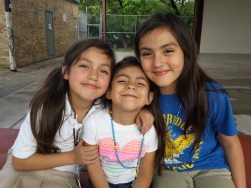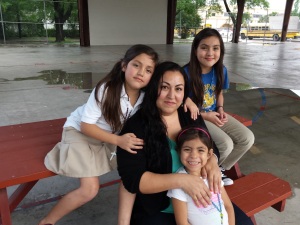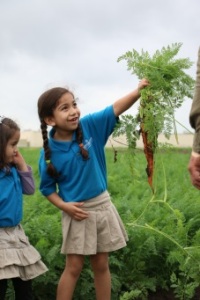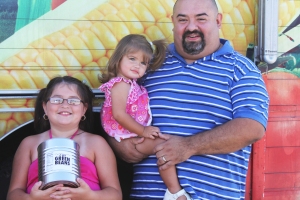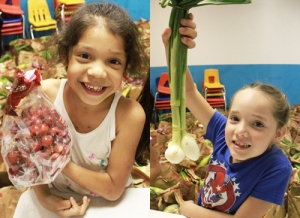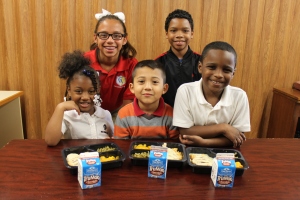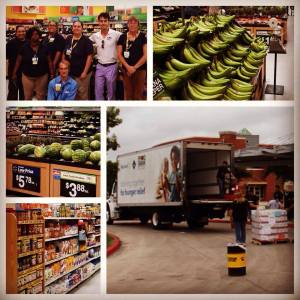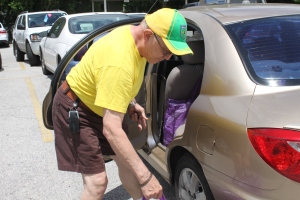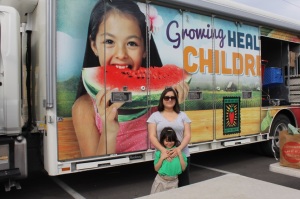When School is the Answer to Food
It’s back to school time and children around our community wait in anticipation to make new friends, meet new teachers and learn new things. Many parents also await the beginning of school with hopes of reducing their stress. Parents like Imelda, who look to school as a place for her children to not only learn, but to also eat.
Since moving to San Antonio a few years ago, Imelda’s life has seen much struggle. Although she recently completed her certification as a medical assistant, finding a job has been difficult. Making ends meet has been even more difficult and she relies on community programs like the San Antonio food Bank to provide for her three daughters
Her girls attend the Guadalupe Community Center, a partner agency of the Food Bank which participates in the Kids Café, an after-school program. Kids Cafes are safe, nurturing places where neighborhood children can go after school and receive a hot supper as well as help with homework from caring volunteers or staff members. “During the school day, they eat at school and because of the Food Bank I know they will eat dinner after school, it’s one less thing I have to worry about,” she says.
Imelda says, “I don’t like being dependent on others for help. I want to work; I want to provide for my family. I am very thankful that the Food Bank exists to help me move forward. And I am grateful that I know my girls always have food.”
Delivering Fresh
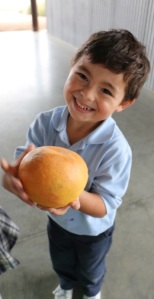 On a recent Farm Fresh Friday delivery, I was surprised and saddened at the look of confusion many of the young children had on their faces. In the bags of this particular distribution were squash, raspberries and cherry tomatoes. As I looked through a bag with one little girl, I asked her what was wrong. “What is all this? I’ve never seen these before,” she said with confusion.
On a recent Farm Fresh Friday delivery, I was surprised and saddened at the look of confusion many of the young children had on their faces. In the bags of this particular distribution were squash, raspberries and cherry tomatoes. As I looked through a bag with one little girl, I asked her what was wrong. “What is all this? I’ve never seen these before,” she said with confusion.
In that moment I was grateful for people in our community who have helped us take our mission to fight hunger, one step further as we teach children about the food we eat. So often, many of the families we serve purchase foods with a shelf life, rather than food that truly nourishes life. As a result, children are almost barred from having any exposure to the fruits and vegetables that so often set our own tables.
As part of our expansion to provide more fruits and vegetables to children, we invite classrooms out to our own farm, to see how food is grown and where it is grown. Their bewilderment is soon replaced with excitement as they hold up carrots they helped to harvest. “I can’t wait to eat this!” “I can’t wait to share this with my grandma!” These are the statements our children should be making as they reach deep into bags of fruits and vegetables you have helped to provide.
Farm Fresh Friday is a weekly distribution made to area programs on Friday’s. Each bag contains fresh produce for the weekend and will often include a recipe a family adult can use to prepare a nourishing meal. As partners distribute bags to children, they remind them of the many fun and healthy ways they eat their vegetables. Many children arrive home prepared to instruct their families on a delicious recipe.
In addition to our Farm Fresh Friday distributions, the Food Bank provides gardening and nutrition classes to area children to engage them in the fun of eating healthy. Gardening classes teach them about the life of a vegetable and how they can grow a garden in their own backyard or porch.
Genoveva and Juan
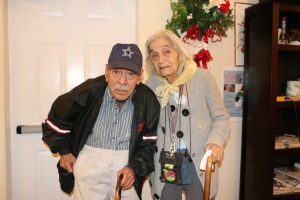 Her voice still hoarse after being intubated for surgery to repair her broken shoulder after a fall, Genoveva struggles to talk. At 80, she and husband Juan, (86) have been married 56 years. They have participated in the senior program at Bethel Neighborhood Council for nearly 10 years; a blessing for the couple living on a fixed income. With some help from their children, Genoveva is the primary caretaker for Juan who is deaf and struggles with dementia. The two move around the lunch table slowly with their canes; Genoveva guiding Juan by the arm. Their monthly income is just slightly over the limit to qualify for food stamps, but not enough to ensure they have sufficient food to eat each month. They eat two meals at the center and often skip supper to ensure their food lasts. The commodities box they receive from Project HOPE supplements their meals from the center. When they run low on food a neighbor will often bring nachos to share with the couple. They are grateful for the help they receive from the center and the San Antonio Food Bank.
Her voice still hoarse after being intubated for surgery to repair her broken shoulder after a fall, Genoveva struggles to talk. At 80, she and husband Juan, (86) have been married 56 years. They have participated in the senior program at Bethel Neighborhood Council for nearly 10 years; a blessing for the couple living on a fixed income. With some help from their children, Genoveva is the primary caretaker for Juan who is deaf and struggles with dementia. The two move around the lunch table slowly with their canes; Genoveva guiding Juan by the arm. Their monthly income is just slightly over the limit to qualify for food stamps, but not enough to ensure they have sufficient food to eat each month. They eat two meals at the center and often skip supper to ensure their food lasts. The commodities box they receive from Project HOPE supplements their meals from the center. When they run low on food a neighbor will often bring nachos to share with the couple. They are grateful for the help they receive from the center and the San Antonio Food Bank.
Running on Low
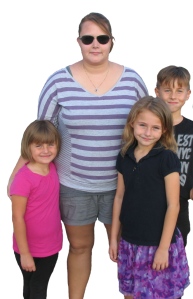 Last year, when asked what Thanksgiving might look like for her and her family, Laura’s response is not what you might expect for a family with four kids. “We’ll try to save everything we can,” she said, “but it will probably be mashed potatoes, maybe some fruit, and a turkey if we’re lucky.” It might not be the full, traditional spread most people are used to, but she hoped it would be a little something different to mark the holiday for her family. This trend of saving and stretching has been the reality for Laura and her husband for the past year, since just before her sister recommended she utilize the Food Bank’s services. Around that time, Laura was beginning to show signs of health issues. Soon after, she was diagnosed with several debilitating illnesses, making it impossible for her to continue working. In addition, her son’s autism required that she spend more time with him at home, eventually leading to her unemployment.
Last year, when asked what Thanksgiving might look like for her and her family, Laura’s response is not what you might expect for a family with four kids. “We’ll try to save everything we can,” she said, “but it will probably be mashed potatoes, maybe some fruit, and a turkey if we’re lucky.” It might not be the full, traditional spread most people are used to, but she hoped it would be a little something different to mark the holiday for her family. This trend of saving and stretching has been the reality for Laura and her husband for the past year, since just before her sister recommended she utilize the Food Bank’s services. Around that time, Laura was beginning to show signs of health issues. Soon after, she was diagnosed with several debilitating illnesses, making it impossible for her to continue working. In addition, her son’s autism required that she spend more time with him at home, eventually leading to her unemployment.
However, with Laura out of work and four kids to feed, her husband had to secure a second job. In spite of his workload, they began to struggle with meeting the families basic needs. Laura describes herself as a “do-it-yourself person”, so asking for, and accepting help, was difficult for her. On the most challenging days, she would often go without food to ensure that her kids were able to eat; sometimes sustaining herself with just a protein shake. In the hardest of times, she says the easiest thing to do is make lots of rice and to add soup to meals to make food stretch.
A recent Hunger study found that 7 in 10 households report having to choose between paying for food and other necessities like gas and utilities. Laura echoed this statistic saying that they rarely have enough money for both food and gas, requiring them to walk most places or to not leave at all. This means not doing things like spending holidays with family because they can’t afford the gas. Laura said that they often have to stretch the money for electricity and other utilities, leaving lights off in the house and instead using flashlights at night to save every penny to ensure her kids do not go hungry. Another statistic states that half of food insecure clients water down food or drinks in order to make them last longer. Laura agrees that this is a tactic used in their family, adding water to the milk to make it last, as well as eating meals comprised mostly of pancakes and spaghetti.
Laura expressed her frustration at not being able to do more on her own to provide food for her family, saying that when she lived in the countryside there was more available ground for growing food. However, since the family has had to relocate to a trailer community, gardens are not allowed. They try and grow some foods inside the trailer, but this cannot be relied on for large amounts of fresh food. When she thinks of all the good the Food Bank has done for her family, especially in the case of fresh food, she is grateful. She is able to get the foods that provide essential nutrition for her and her family, knowing that although it will still be tough, it won’t be impossible.
Looking to the future, Laura does not see the situation as permanent. Although her health issues are serious, she says that she is “still trying” and is “not going to let it put [her] in a box.” An obviously strong, empowered woman, she says that “disability just means I have more to overcome.” She looks forward to the day when they will be able to afford a place of their own, nothing fancy, but something that is just theirs. Her husband used to be a carpenter, and Laura says they will fix whatever they need if they find something they can afford. “This is only a season,” she insists, knowing that someday her family will not have to rely on the Food Bank. For now, she is thankful the Food Bank is there to help her in this time. This Thanksgiving, they will not go without.
A Veteran’s Journey
The sidewalks are bustling as you walk up to the American GI Forum. Scattered with people who live there, and up the street at Haven for Hope. Some live nowhere. Some sing on the steps of the building. While others are begging for money.
American GI Forum is one of 535 partner agencies working with the San Antonio Food Bank to combat hunger in our community. Once a week, Rosemary Aguilar, am employee, picks up more than 1,000 pounds of food from the Food Bank, that will eventually be cooked and served to residents at the facility. She says food from the Food Bank accounts for nearly 90% of what they feed their veterans.
The facility has a capacity of 125 beds, which at any given time is nearly full with male and female residents who have served our country in the military. The program is intended to prevent homelessness amongst the population of veterans—many of who have no family or friends, and some who struggle with addiction after serving in the military. The past few years, the average age of residents Rosemary sees are between the age of 30-40. The facility serves both short-term and long-term residents, who have been honorably discharged from the military. Short-term residents are assisted in finding long-term housing needs and permanent residents have the comfort of a room in a dorm-style wing of the facility.
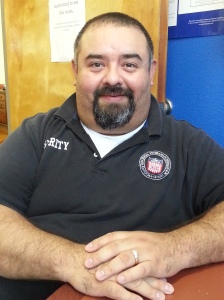 One of the veterans found in the lobby, isn’t a resident, but an employee. Mike served in the Navy for 10 years. He’s proud of the service he provided to his country. He loves working in an organization that supports and re-directs veterans. He explains why he thinks so many veterans he sees walk through these doors struggle with addiction. “When you send someone off to war, you don’t realize how much it changes them,” he says. “They don’t come back the same.” He goes on to explain how difficult the transition is from military life to civilian life. Many people can’t make it. He should know. Mike is one of them.
One of the veterans found in the lobby, isn’t a resident, but an employee. Mike served in the Navy for 10 years. He’s proud of the service he provided to his country. He loves working in an organization that supports and re-directs veterans. He explains why he thinks so many veterans he sees walk through these doors struggle with addiction. “When you send someone off to war, you don’t realize how much it changes them,” he says. “They don’t come back the same.” He goes on to explain how difficult the transition is from military life to civilian life. Many people can’t make it. He should know. Mike is one of them.
Mike isn’t just employed with a partner agency; he also has to seek assistance from partner agencies. When discharged in 2006, his family was succeeding financially and wanted for nothing. But when his job search had gone on a year, and his savings tapped out, Mike moved his family to Detroit to find work and live with his in-laws. Shortly, Detroit crashed and no one could find a job. Mike moved back to San Antonio to find work and was separated from his wife Shannon and their three girls for more than six months. It was hard for him moving from relative to relative while looking for work. He even took day labor jobs, lining up at 5:00 a.m. every morning, hoping he might get a job for the day. This wasn’t the future he had dreamed of when he said good bye to the military.
This is a life Mike never imagined for himself or his children. He feels blessed to have found the job at the American GI Forum. Employed, he quickly moved his family back to San Antonio and hoped to turn their lives around. He qualified for a veteran housing program and bought a home on the City’s east side. But soon, violence in schools made him and his wife feel uneasy about sending their girls to school, so Shannon began homeschooling. Now, the family struggles to make ends meet.
“I’m struggling each month to keep above debt, but we just can’t make it. Little things set us back—a broken down car, medical expenses. I feel like I’m constantly drowning,” Mike shares. Mike is a proud father and when he started “shopping” at his parents’ home for groceries he knew it was time to put his pride aside and ask for help. They applied for and received food stamps while they got back on track. Things were looking up and then started falling apart again. Not wanting to re-apply for food stamps, Mike chose to seek another form of assistance: food from a food pantry. “I feel embarrassed. There’s no other way to say it. What man would want to say I can’t provide for my family? But I know it helps us,” Mike says with his head down.
Mike is happy that he can be instrumental in helping vets get their lives back on track and improve their current situations. He knows many of the men and women who walk through his front doors would be homeless if it weren’t for the agency. He is equally grateful for the assistance of the Food Bank, “There aren’t enough words to express my family’s gratitude. I don’t want to think about what would happen to us if we couldn’t access the pantry. Even my elderly neighbor goes to the pantry. There are more people than you think who struggle to eat.”
Making Back to School, Cool!
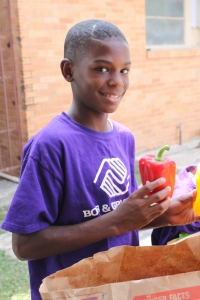 This summer, the San Antonio Food Bank led an aggressive campaign to meet the needs of children who are at risk of food insecurity during the 11 weeks of school vacation. With your help, we collected food and funds to help provide more than a million summer meals for kids and their families. But the campaign isn’t over yet, as summer comes to a close and the excitement of school builds, there are still so many children who need our help.
This summer, the San Antonio Food Bank led an aggressive campaign to meet the needs of children who are at risk of food insecurity during the 11 weeks of school vacation. With your help, we collected food and funds to help provide more than a million summer meals for kids and their families. But the campaign isn’t over yet, as summer comes to a close and the excitement of school builds, there are still so many children who need our help.
Not only did we do a tremendous job ensuring that children, who may have gone hungry with no access to their usual school meals, were fed. But we also fed children food they have never had access to. Nine year old Alanah learned how to cook and eat spinach for the very first time in her life at our Healthy Cooking Class. Six year old Christy, who had never tasted a grape, yelled, “This is better than a cookie!” when she received her bag full of produce in our Farm Fresh Friday program.
We learned from children that their parents had to make tough choices. “My mom doesn’t buy that many fruits or vegetables because we can’t afford them,” said twelve year old Isaiah. A child should never know their parent has to make tough choices. The school year should be a time of learning and being a child.
Many children who receive food from the Food Bank are eager for school to start. When school is in, a meal is guaranteed. They look forward to a breakfast in the cafeteria with their friends and lunch in the same spot. Knowing they can rely on this meal, a child can focus on important learning. The San Antonio Food Bank happily ensures that an after-school snack and dinner are provided at the end of a long day. During the school year, the San Antonio Food Bank continues to nourish children through our after school Kids Cafés and our Friday Backpack Program. Both of which are often the last healthy meal of the day.
The future of so many children is directly impacted by our community and the support ensures children have the nutrition needed to excel in school and ultimately have access to better opportunities in life.
For more information about our Kids Cafe’s and Backpack Program, please contact (210) 431-8331 or visit safoodbank.org.
The Cafe is Open
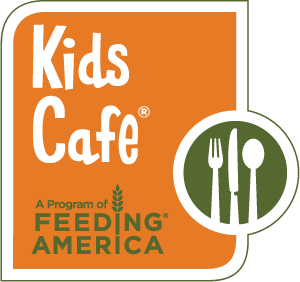 School Time Is Meal Time
School Time Is Meal Time
School is just around the corner and for many children in our area, school doesn’t just mean access to education, it means consistent access to nutrition. One of the many ways the San Antonio Food Bank works to fight hunger is through our Kids Cafe Program.
What is a Kids Cafe?
A Kids Cafe confronts childhood hunger by serving as a direct feeding partnership between an area Food Bank and an after-school program. Kids Cafes are safe, nurturing places where neighborhood children can go after school and receive a hot supper as well as help with homework from caring volunteers or staff members. The San Antonio Food Bank sponsors several Kids Cafe sites, partnering with local after-school programs to bring this effective child nutrition program directly to the children and teens at the youth centers where they recreate.
Why are They Needed?
Each year in the United States, more than 25 million people visit a food bank because of hunger or food insecurity. Nearly 40 percent of emergency food clients are children. In San Antonio, one in four children experience hunger. Many children in low-income neighborhoods or rural communities do not receive well-balanced evening meals, either because their parents work late hours or they simply cannot afford good wholesome food. Children must receive proper nutrition in order to develop properly and perform well in school. Many Kids Cafes are located in central locations so that participating children can walk or bicycle to these sites after school for a hot meal and homework assistance from a caring adult.
Last school year, the San Antonio Food Bank provided more than 5,000 children with more than 65,000 meals through our Kids Cafe program. Children enjoyed the comfort of their after-school site and a hot meal with friends and loving teachers.
One such site, Presa Community Center, has partnered with the San Antonio Food Bank for nearly 13 years as a site for the Kids Café, BackPack Program and the Summer Food Service Program to ensure area children continuosly receive the nutrition they need. Franki Martin, Vice President of Presa Community Center, says, “To see a child’s faces lit up in gratitude is priceless. To know that the Kids Cafe has sparked those winning smiles is a wonderful feeling. Kids should not have to be worried about their next meal. To know that we are here to ease that burden is really important to us.”
As we approach the new school year, children are waiting to ask: what’s for dinner?!
To find a participating Kids Cafe near you, contact (210) 431-8331 or visit http://www.safoodbank.org.
Walmart Gives Back
Thank you Walmart for being a great community partner and helping us provide fresh and non-perishable products to families in need.
We are happy to announce that in fiscal year 2014 Walmart donated 2,585,871 pounds of food to the San Antonio Food Bank.
Feeding HOPE
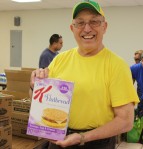 The sounds of “God Bless America” mark the beginning of meal time for the seniors of the Kenwood Community Center, one of the San Antonio Food Bank’s original 20 agencies served through Project Hope. Project Hope (Healthy Options for the Elderly) began in May 2003 as a way to provide free groceries for seniors after the Food Bank was approached by the City with a request to partner in an effort to reduce senior hunger. City officials noticed senior participants hoarding and hiding food from lunch at the senior centers. Concerned the seniors might become ill, officials approached the Food Bank for a solution. Jane Denkewalter, Senior Programs Manager, helped to start the program as a volunteer. According to Denkewalter, Project HOPE partners with 133 partner agencies and is now serving almost 8,000 unduplicated seniors each year. Each box is filled with about 35 pounds of nutritious food per senior and is delivered directly to the partnering agencies by the Food Bank, with about 80 seniors per site. These seniors may either be accessing food in Bexar County or in one of the Food Bank’s rural communities. The need is higher in the rural communities, but the Food Bank has gaps in Bexar County that need to be covered as well.
The sounds of “God Bless America” mark the beginning of meal time for the seniors of the Kenwood Community Center, one of the San Antonio Food Bank’s original 20 agencies served through Project Hope. Project Hope (Healthy Options for the Elderly) began in May 2003 as a way to provide free groceries for seniors after the Food Bank was approached by the City with a request to partner in an effort to reduce senior hunger. City officials noticed senior participants hoarding and hiding food from lunch at the senior centers. Concerned the seniors might become ill, officials approached the Food Bank for a solution. Jane Denkewalter, Senior Programs Manager, helped to start the program as a volunteer. According to Denkewalter, Project HOPE partners with 133 partner agencies and is now serving almost 8,000 unduplicated seniors each year. Each box is filled with about 35 pounds of nutritious food per senior and is delivered directly to the partnering agencies by the Food Bank, with about 80 seniors per site. These seniors may either be accessing food in Bexar County or in one of the Food Bank’s rural communities. The need is higher in the rural communities, but the Food Bank has gaps in Bexar County that need to be covered as well.
More than 100 seniors attend Kenwood Community Center. Rosalee Aguilar, Senior Nutrition Supervisor for the Center, describes most of her senior participants as living alone with little to no support outside of the Center. She says, “I see many of them struggling to make ends meet. They come in asking for rental assistance, utility assistance and more. With the rising cost of food, I am glad we can partner with the Food Bank to provide them with a basic need.” During the summer, she sees an increase in attendance because of the air conditioning available at the center. “For many of them, it’s just too hot to stay at home. They won’t turn on their air conditioning units for fear of incurring an extra expense they can’t afford,” Rosalee explains. Rosalee goes on to say, “It’s hard for our seniors, because many of them are on fixed incomes and find it hard to make ends meet at the end of the month.”
John is one of those seniors. A vibrant, happy man, John stands out from the crowd. At the young age of 73, he has the appearance of a 60 year old. Health is important to him and he makes sure to work out 3 times a week. “I didn’t take care of my health in my younger years and I realized this is the body I have. I have to take care of it,” he says. He goes on to express gratitude for the healthy foods he receives from the monthly commodities box. “I especially love the veggies and fruits at the Senior Farmers’ Market. I am unable to purchase fresh produce very often on my income.” For John, Project HOPE has been a blessing. Having never married or had any children, John relies on the company of the friends at the senior center and on the food he receives. “I think the world of the food here. It’s such a tremendous blessing. Not just for me but for the people who have become my friends,” John explains. “Believe it or not the powdered milk and oatmeal are my favorites,” John exclaims. “It’s the simple things you take for granted.”
“I’m a lucky one. I’m still active and I started taking better care of myself early enough to live longer. But many of the people here, I notice, really struggle—not just to make ends meet, but just to come to the center, get out of the heat, make it through each month,” John reflects sadly. For many of the seniors, the Community Center and the food provided by the Food Bank are their link to life—living life and ensuring they receive the sustenance to continue to live.
John expresses his gratitude for those who help make the Food Bank’s program possible, “You never know when you are someone’s life line. You never know how much life that one dollar you give, provides for someone. They count on it. We count on it.”
Seniors can access Project H.O.P.E. by calling (210)431-8326 or visiting www.safoodbank.org. If you would like to help a senior like John, please visit our website for your gift of food, time or money.
From Farm to Table
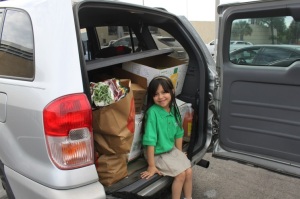 Just outside the campus of KIPP: Un Mundo academy, a line of cars loop around the parking lot after picking up their kids once a month. They are not waiting to meet their child’s teacher, nor are they waiting to drop their child off at soccer practice. They are waiting for something much more basic: food. With every car that is packed with food another joins the line, almost 120 vehicles moving continuously around the lot, windows down to relieve the heat. For more than an hour the cars continue to move slowly towards perhaps their only source of healthy food for the month. Many families will receive their food and then take their children to football practice or dance. Yet the long wait for produce and food basics is worth the time in order to sustain their children during these activities and for the rest of the month.
Just outside the campus of KIPP: Un Mundo academy, a line of cars loop around the parking lot after picking up their kids once a month. They are not waiting to meet their child’s teacher, nor are they waiting to drop their child off at soccer practice. They are waiting for something much more basic: food. With every car that is packed with food another joins the line, almost 120 vehicles moving continuously around the lot, windows down to relieve the heat. For more than an hour the cars continue to move slowly towards perhaps their only source of healthy food for the month. Many families will receive their food and then take their children to football practice or dance. Yet the long wait for produce and food basics is worth the time in order to sustain their children during these activities and for the rest of the month.
The dual language elementary school encourages its needy families to take advantage of the Mobile Food Pantry, a Food Bank distribution truck that hands out boxes of sustenance to those that come through the line. Each mobile pantry can provide for about 200 families and is filled with a variety of produce and other frozen and refrigerated foods for a family in need. Last year, the Mobile Food Pantry distributed over 5.1 million pounds of food to over 58,000 individuals. The Food Bank partners with KIPP through the Mobile Food Pantry as well as in a number of other ways, including providing food for students during the school day. At the KIPP: Un Mundo distribution site, about 120 families come through at each monthly delivery, the majority of which are KIPP parents and students.
Chloe, age 27, is one of those parents, waiting for food for almost an hour with her six-year old daughter in the back seat. She has been coming to the KIPP mobile food pantry almost every month for a year after she was notified of her eligibility by the school. Her youngest daughter, only 2 years old, waits at her mother’s home, Chole’s current place of residence. Chloe’s husband returned from deployment 5 months ago, and although they hope to someday to afford a home of their own, the last 8 years of his service have been financially difficult for Chloe and her family. Chloe and her daughters moved in with her mother in San Antonio a year ago when her husband was deployed. This has helped ease some financial burden, but she says that it has been difficult because her mother “felt she had to provide for everyone when he was deployed.” Now that Chloe’s husband is retired from the military, he has a day job roofing, the couple’s only source of income. However, it can be especially difficult to budget money when the checks he receives are only every few weeks and for inconsistent amounts.
Chloe is a stay-at-home mom who recently completed school to be a dental assistant, and is now working on the last steps of her qualifications. She is trying to complete the process so that she can work soon, especially since much of the money used to pay for school has come from her savings. With these costs on top of her husband’s sporadic income, providing adequate, nutritious food to her children can be difficult. Some of that financial burden of feeding her family is relieved by the food she receives from the Food Bank. She stressed how important the healthy food from the Food Bank was to her family, saying that without the distribution they would have to make additional financial cuts to find ways to afford such foods. She expressed appreciation for how the “really healthy food helps give kids healthier options.” Nutrition is so important for children, especially those at such critical ages as her youngest daughter, only 2 years old. Good health and eating habits begin at any early age, and the Food Bank is enabling Chloe to teach her children what it means to eat right.
“The Food Bank just gives so much,” Chloe said, which is especially helpful to her family since she supports her mother with the food boxes as well. Older men and women also need strong nutrition through in their food, since there are a number of vitamins that help prevent disease and ease aging that can be obtained with healthier food. As someone who is working to a better future for her family, Chloe appreciates the help of the Food Bank and KIPP during this transitional and difficult time.
The San Antonio Food Bank continues to help families throughout the summer. If you would like to help us, please contact (210) 337-3663 to find out how you can help through food, time or money. You can also visit us at http://www.safoodbank.org.
